Pitch deck? Check.
Business cards? Ready to go.
Lucky underwear? Washed and folded.
Business plan? Uh oh.
So you have an amazing business idea, and you’re ready to pitch it to investors or potential partners. But if you’ve never written a business plan before, it can be downright intimidating to put pen to paper (or fingers to keyboard) and try to condense your entire professional dream into one document.
But here’s the good news: writing a business plan doesn’t have to be a stumbling block on your path to business ownership. Instead, it can be a powerful tool that clarifies your business vision, guides your steps along your business journey, and helps secure the funding and partnerships you need to flourish.
And this article will help you by simplifying the process of business plan writing into smaller, more manageable pieces as well as highlighting all the essential parts of the plan that will bring your business idea to life.
Our aim here is to empower you with the foundational knowledge you need to draft a comprehensive plan that leads to a successful business. From articulating your business idea to conducting market research, defining your business objectives, making financial projections, and more — by the end of this guide, you’ll not only understand what goes into a business plan but also why it’s fundamental for your business’s success.
So read on, and let’s get started. Here’s everything you need to know to write your very first business plan.
What Is A Business Plan?
A business plan is a comprehensive document that outlines your business objectives and details the strategies you’ll use to achieve your goals. It acts as a roadmap for your business, highlighting your plans for product development, marketing, operations, and finance.
It guides your business from the startup phase through establishment and growth, providing direction and helping you to navigate the complexities of running a business.
Types Of Business Plans
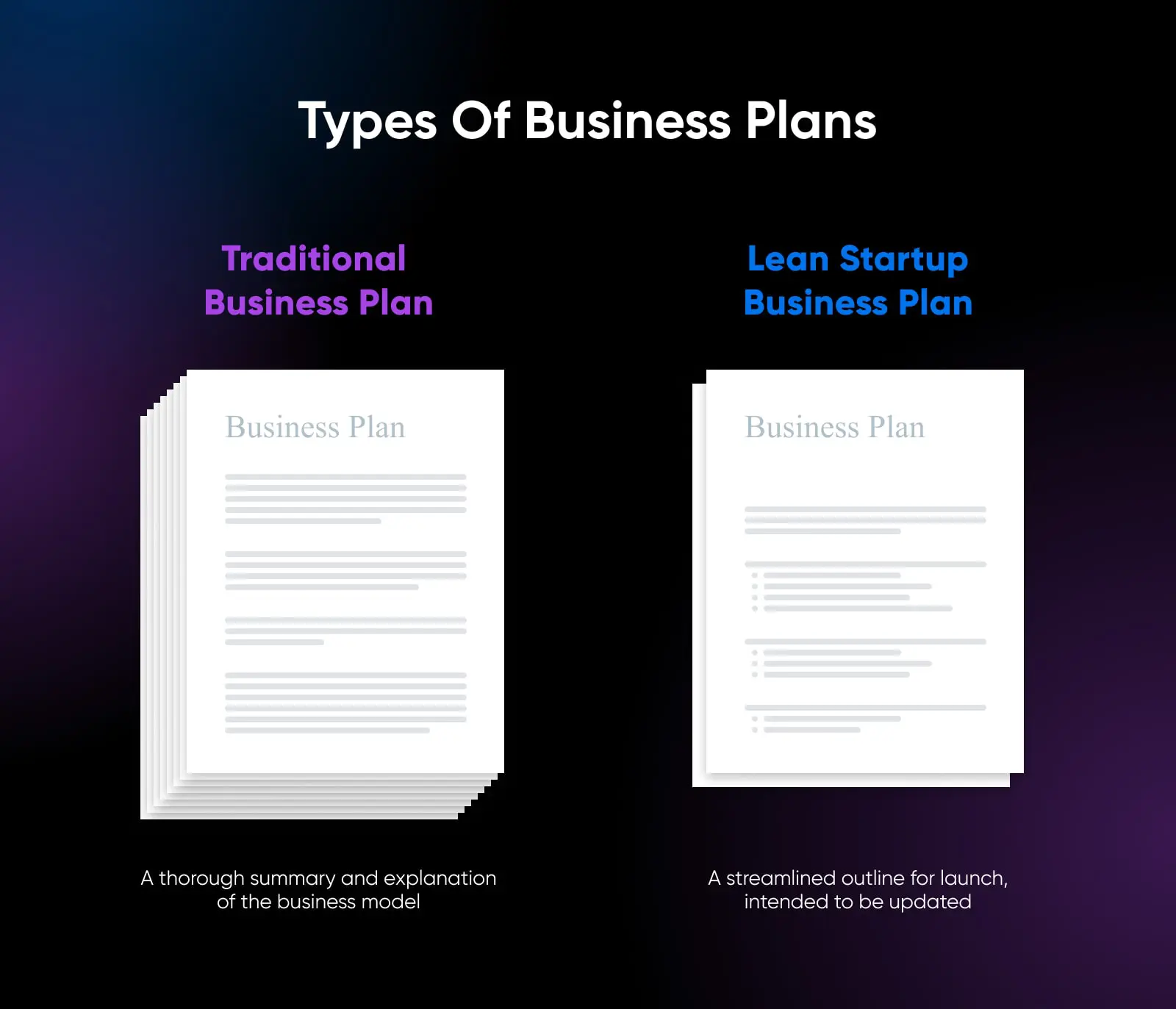
Understanding the common types of business plans can help you choose the right one for your business’s needs. Generally, there are two main categories of business plans:
- Traditional business plan: These are the most common and detailed type of business plan, often favored by banks and investors. A traditional business plan is comprehensive, covering every aspect of the business in depth. This includes executive summaries, company descriptions, market analysis, organization and management structures, sales strategies, funding requests, and financial projections. It’s suited for businesses looking for significant funding or those with a complex business model that calls for a thorough explanation.
- Lean startup business plan: As opposed to the traditional format, lean startup business plans are streamlined and focus on the core elements of your business. They might include key partnerships, activities, resources, value propositions, customer relationships, channels, customer segments, cost structures, and revenue streams. This format is ideal for businesses that want to launch quickly and iterate on their business model. It’s a living document, meant to be updated and adjusted as you learn more about your customers and your market.
In addition to these, business plans can be prepared to cater to a variety of different scenarios and objectives. These include:
- Feasibility plan: Before committing significant resources, a feasibility business plan helps determine if your business idea is viable. It focuses on analyzing the market, competition, and financial feasibility of the project, helping you make an informed decision about proceeding with the business idea.
- Internal business plan: Used primarily for internal purposes, this type of plan focuses on specific goals or projects within the company. It might detail plans for a new product launch, a restructuring of the organization, or any other internal project, without the need for financial projections if external funding is not part of the goal.
- Strategic business plan: This plan outlines the company’s long-term vision and objectives, along with your strategies to achieve them. It serves as a roadmap for the business’s strategic direction, outlining the company’s future goals and how to reach them.
- Business acquisition plan: If you’re planning to buy an existing business, a business acquisition plan will guide you through the process. It includes an analysis of the business’s current condition, how you plan to finance the acquisition, and how you will integrate it into your existing operations.
- Repositioning plan: Designed for businesses looking to change their market position or business model, this plan focuses on strategies for rebranding, targeting new markets, or altering products and services to meet different customer needs.
- Expansion or growth business plan: For businesses aiming to expand operations, whether by opening new locations, entering new markets, or increasing production capacity, this plan details a strategy for growth. It covers market research, financial projections, and operational plans to help ensure a successful expansion.
Why Business Plans Are Important
A business plan is more than a document — it’s a reflection of your ambition, vision, and the blueprint to achieve your business dreams. Whether you’re a first-time entrepreneur or an experienced business owner planning to explore a new venture, understanding the fundamentals of a business plan is the first step toward success.
What Is A Business Plan Used For?
It’s easy to think of a business plan as an old-school formality that isn’t needed anymore now that we’re in the age of fast-moving, agile startups.
However, a business plan isn’t just documentation. Instead, it serves multiple necessary purposes: from crystallizing your business idea to helping secure financing and guiding your strategic direction.
Let’s take a closer look at some of the ways entrepreneurs still use business plans, even for modern startups and tech companies.
1. Communicating Your Business Idea
A business plan is often your business’s first introduction to investors, partners, and stakeholders. It translates your vision into words and numbers, making it easier for others to understand and believe in your idea.
This document articulates the problem your business intends to solve, the solution it offers, and why it’s uniquely positioned to succeed. It serves as a first impression and a pitch, presenting your business concept in a structured and compelling way to capture the interest of potential backers or collaborators.
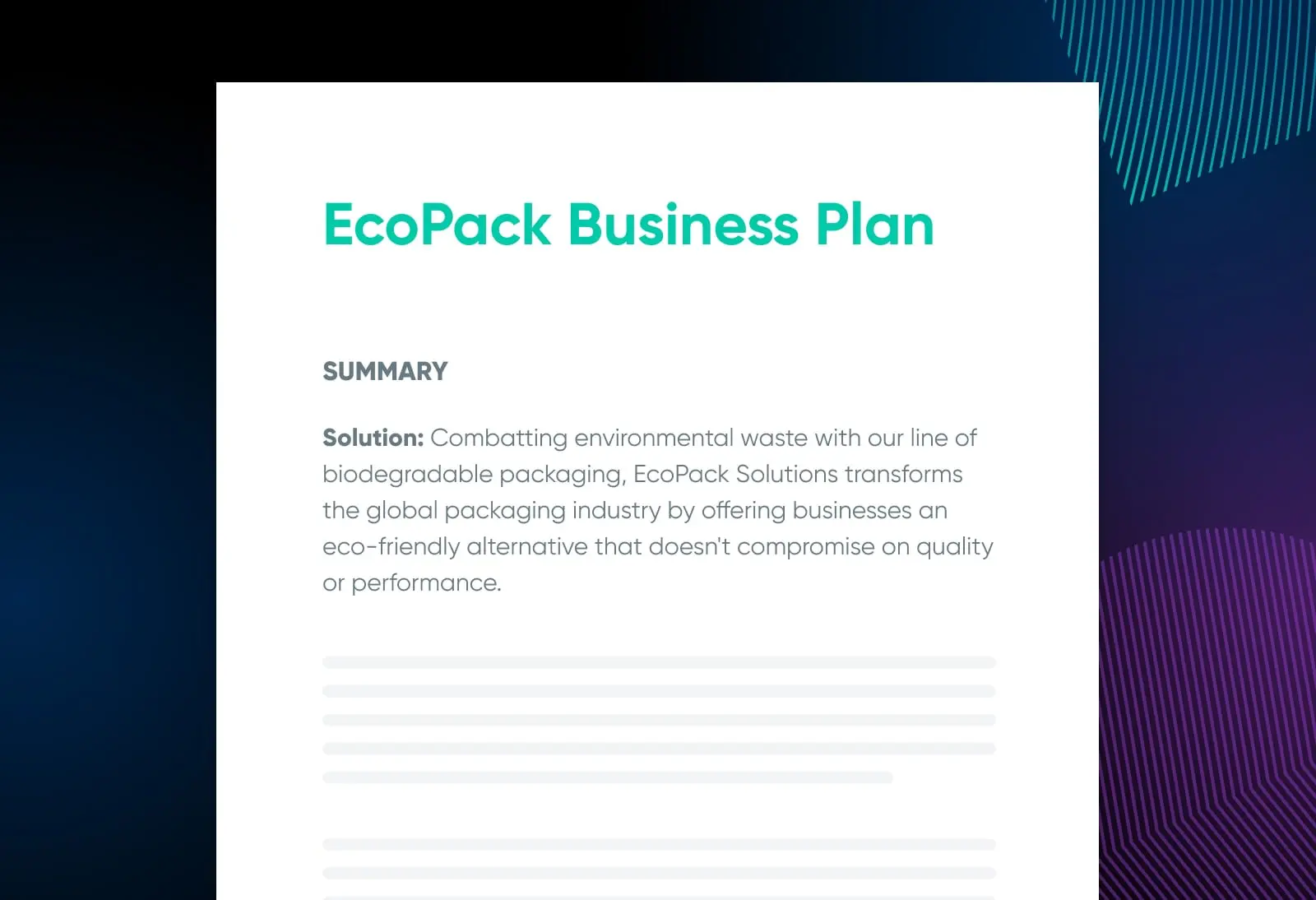
2. Getting Financing For Your Business
One of the most well-known uses of a business plan is to secure financing.
Whether you’re seeking equity investment from venture capitalists, funding from investors, a business loan from a bank, or even support from friends and family, a business plan is a crucial part of that process.
Why? Because it provides potential backers with detailed financial projections, market analyses, and business strategies they want to see before they pitch in. It also demonstrates your business’s potential for growth and profitability, so investors can see how getting involved with you will benefit them.
A thorough and realistic business plan reassures investors and lenders of your business’s viability and your competence as an entrepreneur, which makes it an indispensable tool for fundraising.
3. Documenting Your Business’s Strategy And Goals
A business plan is also an essential tool for internal use. It documents your strategic plan, operational milestones, and the timeline for achieving them. Having a roadmap like this helps guide your team’s efforts, align them with your business’s broader goals, and measure progress as you move forward. It also helps you identify potential challenges and opportunities, so you can proactively manage and respond to market changes.
4. Facilitating Partnerships And Collaborations
A business plan can help secure strategic partnerships and collaborations. It showcases your business model, target market, and competitive advantages, attracting prospective partners who can offer complementary skills, resources, or market access.
5. Guiding Expansion And Growth
For businesses looking to expand, a business plan can outline the strategy for entering new markets or launching new products. It assesses the feasibility of expansion efforts, detailing the required resources, potential hurdles, and projected outcomes.
How To Write A Business Plan: Step-By-Step
Now that you know why a business plan is so important, it’s time to learn what goes into writing one.
Drafting your first business plan can seem like a daunting task. With so much information to gather and decisions to make, knowing where to start is often the hardest part.
However, by breaking the process down into manageable steps, you can create a comprehensive and effective business plan that helps your business succeed.
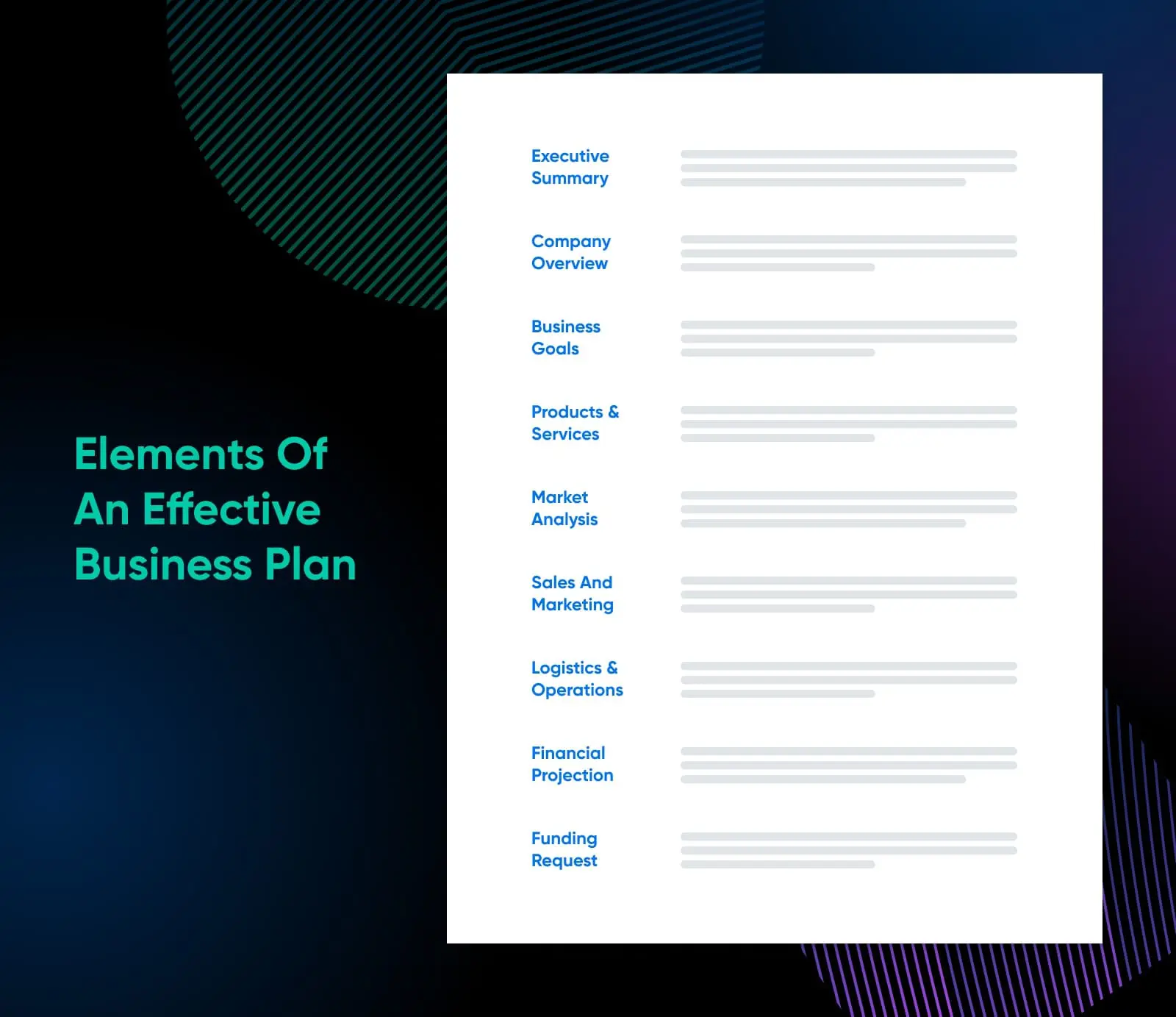
Here are the steps you need to follow.
Step 1: Executive Summary
Every strong business plan starts with a strong executive summary. The executive summary is the opening act of your business plan. It should give a concise overview of the most important aspects of your business.
Despite being placed at the beginning of your business plan, it’s often best to write this section last. This strategy allows you to distill the essence of what follows into a compelling and informative summary once you have a complete understanding of your business plan.
Purpose
The purpose of the executive summary is to capture your readers’ attention, whether they are potential investors, partners, or key employees, and motivate them to read the rest of your business plan. It should highlight your business’s mission statement, foundational goals, primary products or services, and provide a brief overview of your market analysis and financial projections.
For startups seeking funding, the executive summary should also include your funding requirements and what it will be used for.
Components
- Business concept: Start with a clear statement of your business idea, focusing on the problem it solves or the opportunity it creates.
- Products or services: Briefly describe what you’re offering. Explain how your products or services address the problem or opportunity you’ve identified.
- Target market: Describe who your potential customers are, the market size, and any market segments you’ve identified. Show that you understand your audience and competitive landscape and there’s a demand for what you’re offering.
- Competitive advantage: Outline what sets your business apart from the competition. This could be technology, expertise, partnerships, or unique business models.
- Financial highlights: Give a brief snapshot of key financial projections, including sales, profits, and cash flow, if applicable. For startups, mention the funding you’re seeking and its purpose.
- Your team: Introduce the core team members and their roles, especially management or leadership team members. Highlight their expertise and how it aligns with the business goals.
- Your mission statement: Finish with your business’s mission statement, which can help readers understand your core values.
Writing Tips For Your Executive Summary
- Be concise: The executive summary should be no more than a page or two long. It’s an overview, not a detailed account.
- Focus on what matters most: Choose the points that are most compelling and relevant to your audience. What would matter most to an investor or a potential partner?
- Be clear and compelling: Use clear, straightforward language. Avoid jargon and overly technical terms that might obscure your message.
- Try to capture readers’ interest: Your executive summary should make readers want to learn more about your business. Leave them intrigued and looking forward to the details in the following sections.
All in all, the executive summary sets the tone for the rest of your business plan. It’s your first opportunity to make a strong impression, so make sure that it clearly conveys the essence of your business, its goals, and its strategy for success.
Here’s an example of an executive summary for a bowling alley.
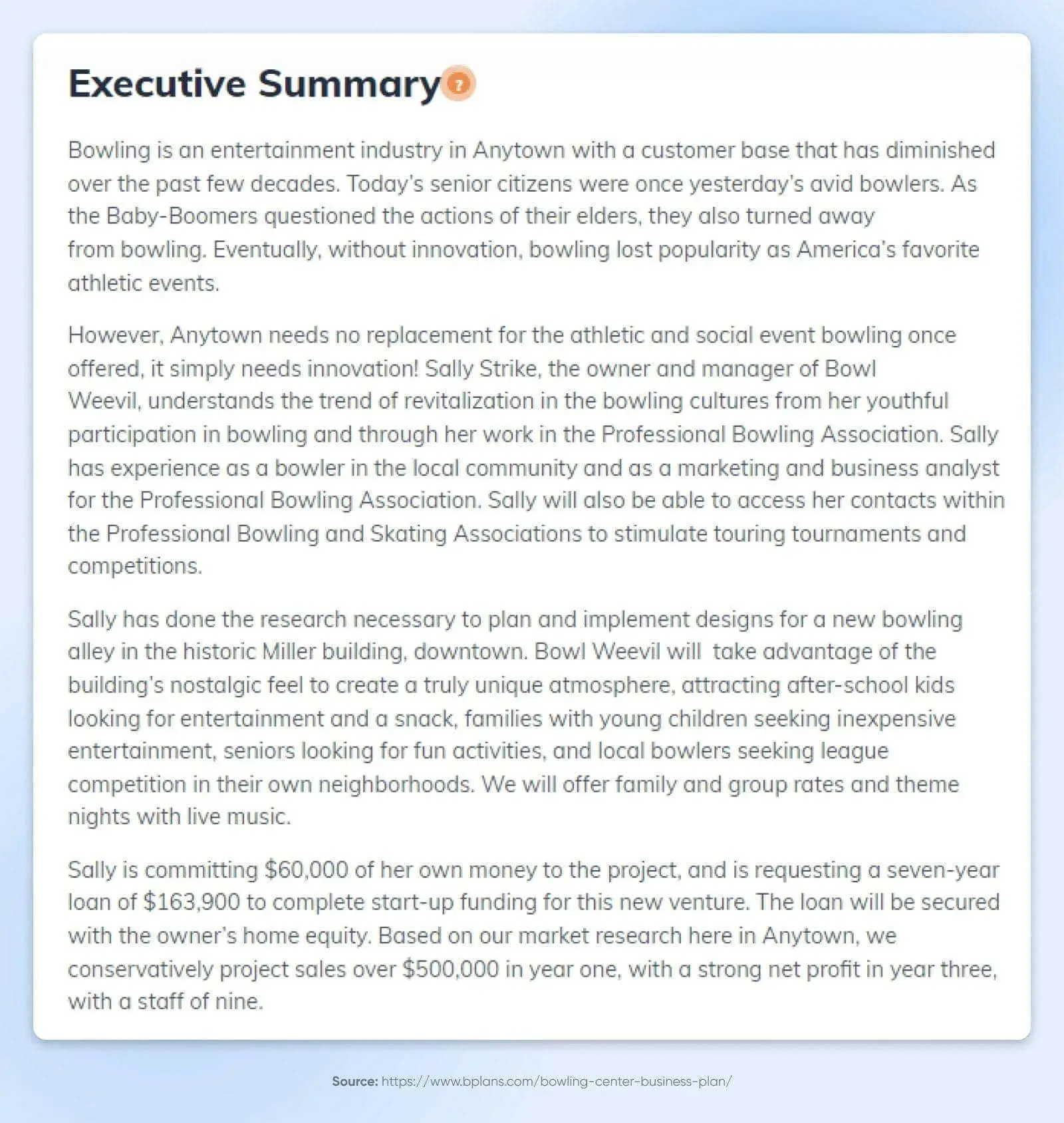
Step 2: Company Overview
Following the executive summary, the company overview section is like your business plan’s foundation. It provides readers with detailed information about who you are, what you do, and the market needs you aim to fulfill.
This section goes deeper into the details of your business’s identity and history, and the path you’ve charted for its future. It’s an opportunity to share the story of your business, including its inception, evolution, and vision for the future.
[bng]
Purpose
The company overview is designed to give readers a clear understanding of your business’s nature, structure, and purpose. It outlines your business model, the specific niche you intend to occupy within the market, and the factors that you believe will contribute to your success. For stakeholders, this section is crucial for understanding the context in which your business operates, including its legal structure, location, history, and the objectives it seeks to achieve.
Components
- Business name and location: Start with the basics — your business’s official name and its physical or operating locations. If you’re digital or online-based, describe how and where you conduct your business digitally.
- History and background: Give a brief history of your business. How, when, and why was it founded? What milestones have you achieved so far? This can include the evolution of your product or service, market expansion, or any pivotal shifts you’ve made in your strategy so far.
- Legal structure: Describe your business structure (e.g., sole proprietorship, partnership, corporation, limited liability company). This affects many aspects of your business, from taxation to your level of personal liability.
- Industry and market: Detail the industry you operate in and your target market. Highlight the current state of the industry, any trends readers should know about, and the segment of the market you aim to serve.
- Products or services: While you’ll dive deeper into this in later sections, provide a brief overview of your main offerings and how they meet the needs of your market.
- Team and management structure: Give a deeper overview of your team members and describe your business’s management team structure. Highlight the experience and expertise that each member brings to the table.
Writing Tips For Your Company Overview
- Be descriptive but concise: While this section is informational, keep it engaging. Avoid overly technical language or industry jargon that might confuse readers.
- Showcase your passion for your business: Let your enthusiasm and commitment shine through. Your company overview is not just about the facts but also about painting a picture of your business’s potential and values.
- Highlight your Unique Selling Proposition (USP): Clearly articulate what makes your business unique. Why should customers choose you over the competition? This could be your business model, approach to customer service, product innovation, or any other differentiators.
The company overview sets the stage for the rest of your business plan by providing a clear snapshot of your business at a glance. It’s your chance to introduce readers to the heart and soul of your business, setting the context for the detailed plans and analyses that come next.
Here’s the company summary of that same bowling alley business plan:
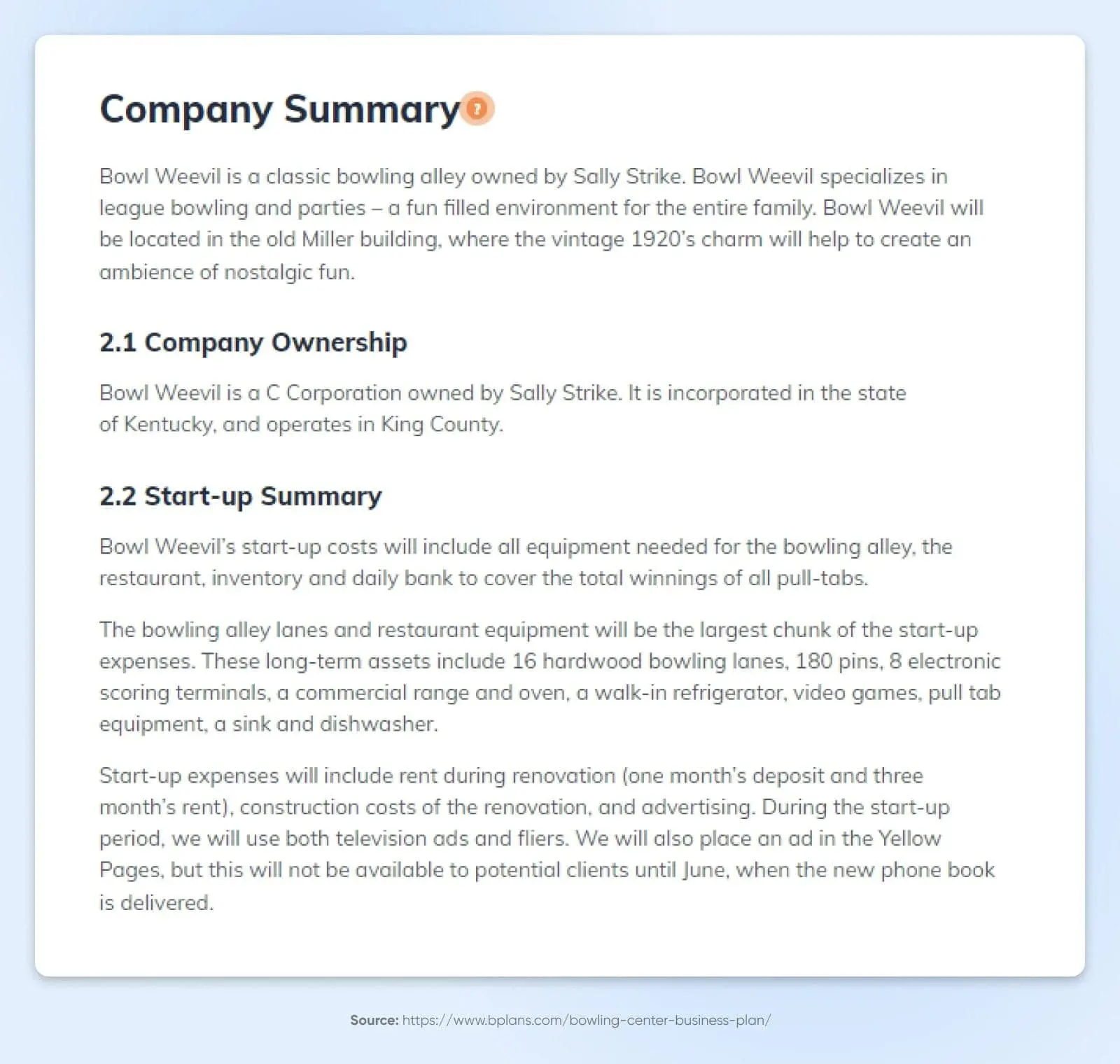
Step 3: Business Goals
After setting the stage with your company overview, the next step is to clearly articulate your business goals. This section is critical as it outlines what you aim to achieve in both, the short and long term. It transforms your vision and mission into actionable objectives, giving readers a clear direction for your business and a benchmark against which to measure your progress.
Purpose
The purpose of the business goals section is to specify your business’s targets and aspirations. These goals should be aligned with your company’s mission, vision, and core values, serving as stepping stones to realizing your broader ambitions. This section communicates to stakeholders what you intend to accomplish, offering a clear framework for decision-making and strategic planning.
Components
- Short-term goals: These are the objectives you aim to achieve in the near future, typically within the next year. Short-term goals could include launching a new product, entering a new market, increasing your customer base by a certain percentage, or achieving a specific sales target. They should be specific, measurable, achievable, relevant, and time-bound (SMART).
- Long-term goals: These goals reflect your vision for where you want your business to be in the next three to five years or beyond. Long-term goals might involve expanding your business nationally or internationally, diversifying your product line, becoming a market leader, or hitting certain financial milestones. Like short-term goals, these should also be SMART but allow for greater flexibility and vision.
- Strategies for achieving your goals: For each goal, outline the strategies or actions you plan to take to achieve them. This could include marketing initiatives, product development plans, partnerships, or operational improvements.
- Milestones to track your progress: Identify key milestones that will serve as indicators of progress toward your goals. These are critical achievements or points in time on your journey to realizing your objectives.
- Resources you need for each goal: Specify the resources (financial, human, technological, etc.) you will need to achieve your goals. This helps in planning for the acquisition or development of these resources.
- Challenges and solutions: Acknowledge any potential obstacles that might hinder the achievement of your goals and outline strategies to overcome them. This shows foresight and preparedness.
Writing Tips For Your Business Goals
- Be specific and realistic: Your goals should be detailed and achievable. Unrealistic goals can demotivate your team and disappoint stakeholders.
- Quantify your goals wherever possible: Attach numbers to your goals (e.g., revenue targets, market share, customer numbers). This makes your objectives clear and measurable.
- Be aligned with your business’s values: Make sure your goals are consistent with your company’s core values and mission. Coherence demonstrates integrity and purpose.
- Be flexible: While it’s important to have clear goals, you must also acknowledge the need for adaptability. Markets and business environments can change, and your goals may need to adjust accordingly.
By clearly defining what you aim to achieve, you provide a roadmap for your team and a compelling case for investors, showing them not just where your business is today, but where it will be tomorrow.
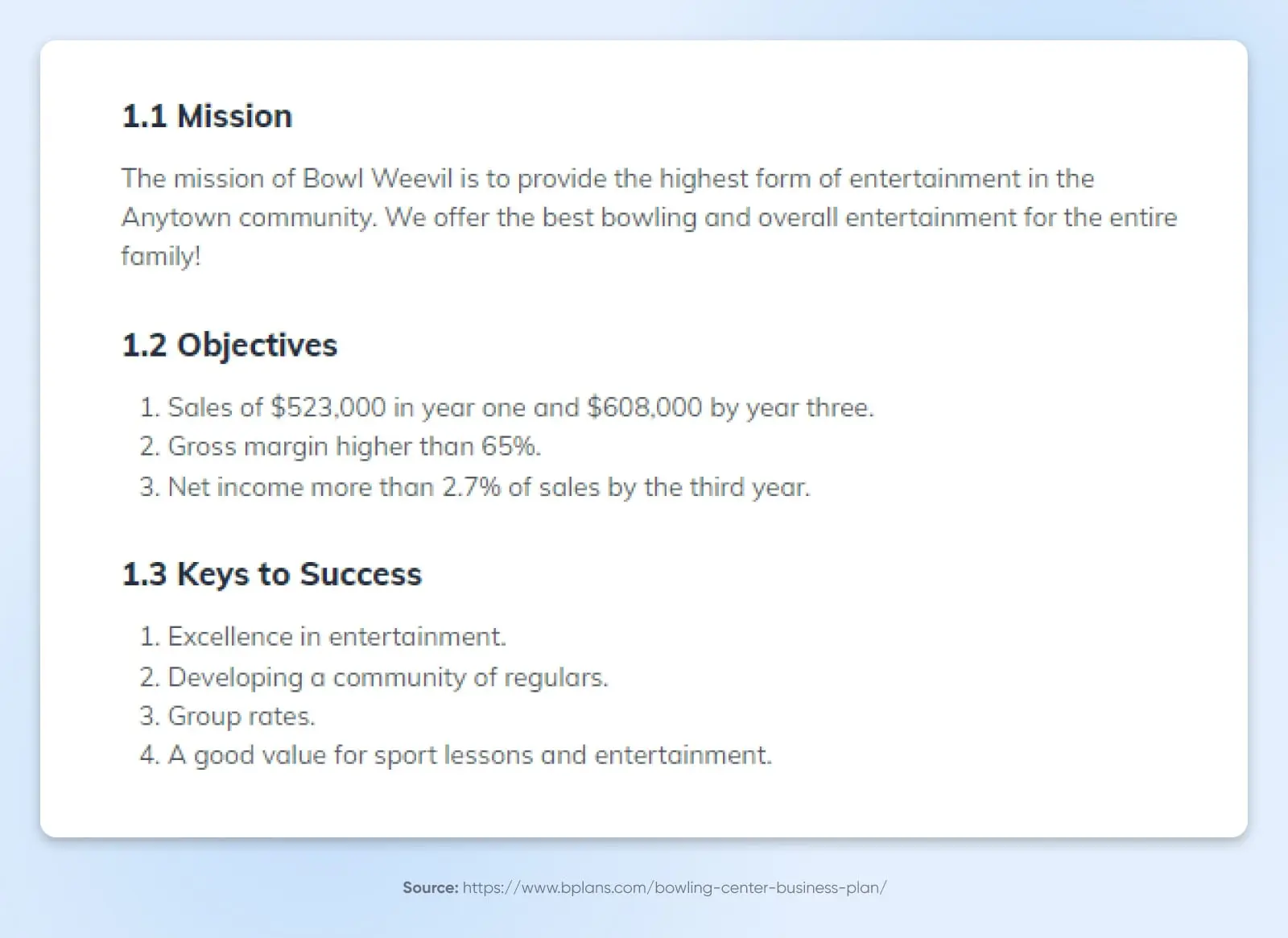
Step 4: Products And Services
The next step is to dive into the heart of what your business offers: your products and services. This section is where you detail what you’re selling, the benefits it offers to your customers, and how it stands out from what’s already available in the market. It’s not just a catalog of your offerings but a persuasive argument for why your products or services fulfill a need or solve a problem more effectively than your competitors.
Purpose
The primary purpose of the products and services section is to explain the value proposition of your offerings. You need to convincingly articulate how your products or services meet a need or address a pain point in the market. This section should make it clear why your business exists and how it intends to deliver on its promises to customers. It’s also an opportunity to showcase the innovation, quality, and uniqueness of your offerings, highlighting how they contribute to your business’s overall goals.
Components
- Detailed descriptions of your offerings: Provide comprehensive descriptions of your products or services, including features, advantages, and specifications. Be clear about how they work and what makes them unique.
- Benefits: Focus on the benefits your products or services offer to customers. How do they improve your customers’ lives or solve their problems? Be specific about the value they provide.
- Your market positioning: Explain where your offerings fit in the current market landscape. Who are your competitors, and how do your products or services differ from theirs? This should include pricing strategy, quality, and any unique features or technologies your business offers.
- Your development pipeline: If your products or services are still in development, outline your progress and future plans. Include timelines, milestones, and any challenges you anticipate.
- Supply and manufacturing: For physical products, describe how they are produced, your supply chain, and any dependencies or potential risks associated with manufacturing. For services, explain the process of delivery and how you ensure quality and consistency.
- Patents and copyrights: Mention any intellectual property protections you have in place, such as patents, trademarks, or copyrights.
- Future offerings: Briefly touch on any future products or services you plan to introduce. This shows investors and readers that you’re thinking ahead and planning for growth and innovation.
Writing Tips For Your Products And Services
- Use customer-centric language: Write from the perspective of the customer and use language that resonates with them, focusing on how your offerings make their lives better or easier.
- Include testimonials or use cases: If they’re available, these provide real-world evidence of your products’ or services’ effectiveness and appeal.
- Be clear and concise: While it’s important to provide detailed information, avoid overwhelming readers with technical jargon or unnecessarily complex descriptions.
- Use visuals: Whenever possible, include images, diagrams, or links to videos that demonstrate your products or services in action. Visual aids can make your offerings more tangible and understandable.
This section helps make the case to investors, partners, and customers about the value and potential of your business’s offerings. By clearly explaining the benefits and competitive advantages of your products and services, you make the argument for why your business is viable and likely to succeed.

Step 5: Market Analysis
The market analysis section of your business plan is where you demonstrate your in-depth knowledge of the industry, your target market, and your competitors. This section provides the factual foundation to support your business strategy, showing that there is a demand for your products or services and detailing how you plan to capture and grow your market share. It’s a critical component that investors scrutinize closely, as it showcases your ability to understand and navigate the market landscape.
Purpose
The purpose of the market analysis is to prove to your readers, whether they’re potential investors, partners, or even team members, that you’ve done your homework. It’s about showing that your business isn’t just a great idea in theory but is viable and competitive in the real world. This section should answer key questions about the size of your target market, trends and growth potential, customer needs and behaviors, and competitive forces.
Components
- Industry description: Start with a broad overview of your industry, including its size, growth rate, and trends. Highlight factors affecting the industry, such as technological advancements, regulatory issues, and economic factors.
- Your target market segment: Narrow your focus to your specific target market. Define your ideal customers based on customer segmentation, demographic, geographic, psychographic, and behavioral factors. Quantify the size of this segment and discuss its growth potential.
- Market needs and preferences: Delve into what drives your target customers. What are their needs, preferences, and pain points? How does your product or service meet these needs better than the alternatives?
- Market trends: Identify and explain the key trends affecting your potential market. How are customer needs changing? What technological or social trends could impact your business?
- Competitive analysis: Provide a detailed analysis of your competitors. Who are they, and what are their strengths and weaknesses? Consider using a framework like a SWOT analysis (Strengths, Weaknesses, Opportunities, Threats) to compare your business with key competitors.
- Market share and position: Discuss your strategy for capturing and growing your market share. How will you position your business against competitors? What unique selling proposition (USP) will you leverage to stand out?
- Regulatory or legal factors to consider: Mention any regulatory or legal factors affecting your industry and how you plan to comply. This is especially important for closely regulated industries like healthcare, finance, and food services.
Writing Tips For Your Market Analysis
- Use reliable data: Support your analysis with up-to-date, reliable data from trusted sources. Charts, graphs, and tables can help illustrate your points more effectively.
- Be realistic: While it’s important to be optimistic, your analysis also needs to acknowledge potential challenges and how you plan to address them.
- Know your audience: Tailor your market analysis to your readers. For example, if you’re seeking investment, focus on aspects that highlight market opportunities and your competitive advantage.
- Stay current: Markets evolve, so update your business plan periodically so your market analysis reflects the most current data and trends.
A thorough market analysis not only proves the viability of your business idea but also demonstrates your strategic thinking and planning capabilities.
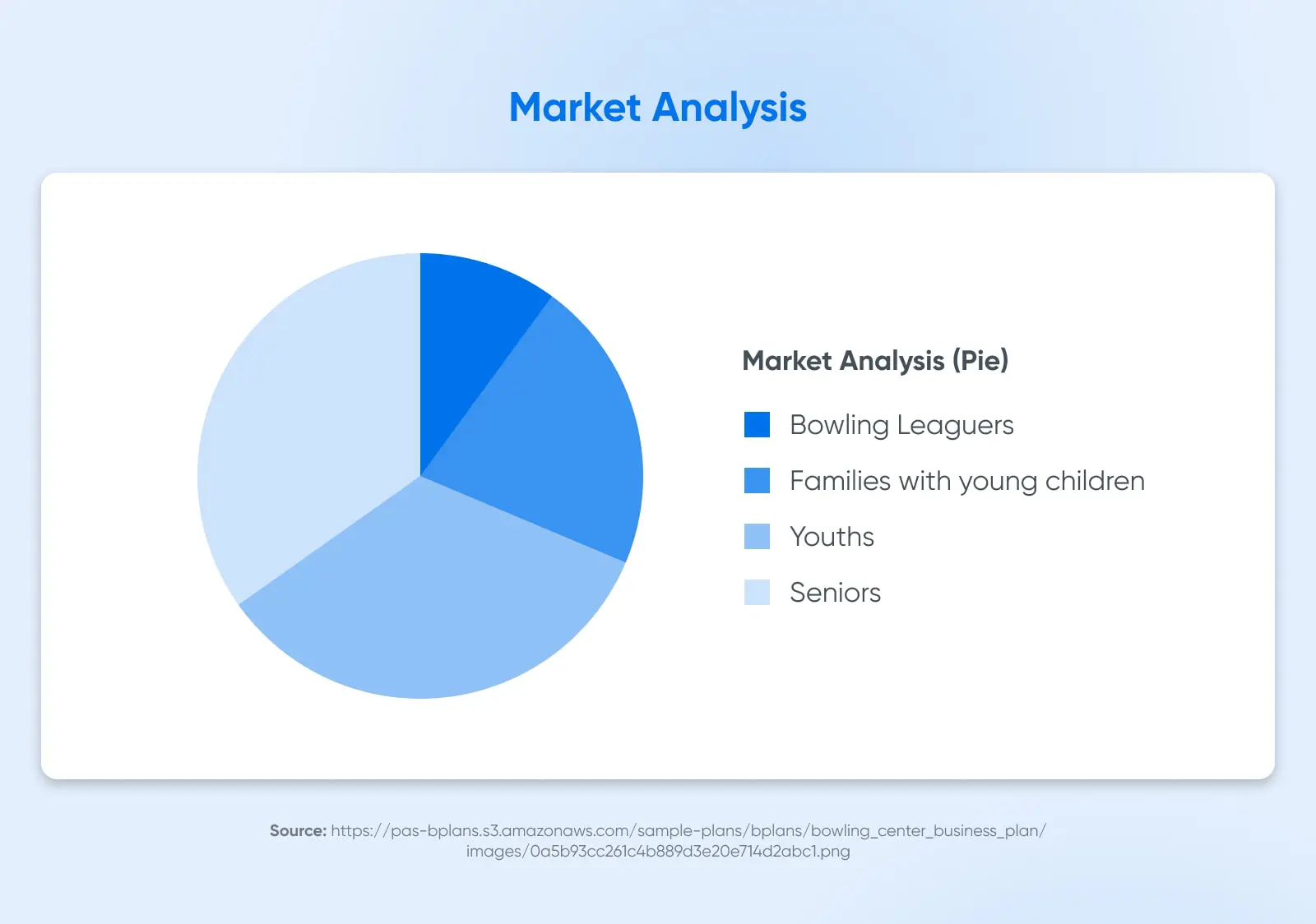
Step 6: Sales And Marketing
After presenting a thorough market analysis, the next step in your business plan is to outline your sales and marketing strategy. This section explains how you intend to attract and retain customers, the channels you’ll use to sell your products or services, and how you’ll position yourself in the competitive landscape. It’s where you translate your understanding of the market into actionable strategies that will drive revenue and growth for your business.
Purpose
The sales and marketing section demonstrates your approach to entering and growing within the market. It should convey that you have a deep understanding of your target customers, how to reach them effectively, and how to persuade them to choose your offerings over the competition’s. This part of the plan will be essential in the eyes of investors and stakeholders, because it shows how you plan to generate revenue and, ultimately, profit that will give them a return on their investment.
Components
- Your marketing strategy: Detail your strategy for reaching your target market, including branding, messaging, and the marketing channels you plan to use (e.g., social media, email marketing, SEO, content marketing). Explain how your marketing efforts will align with the needs and behaviors of your target audience.
- Your sales strategy: Describe your sales process, from lead generation to closing the sale. Include information on sales channels (online, brick-and-mortar, direct sales, wholesalers), pricing strategy, sales forecasts, and any sales teams or partnerships you plan to leverage.
- Positioning: Explain how you’ll position your business and offerings within the competitive landscape. What is your unique value proposition (UVP), and how will it appeal to your target market? How does your pricing strategy reflect your positioning?
- Promotional plans: Describe some of the promotional activities and campaigns you’ll use to attract customers. This could include advertising, special offers, sponsorships, or events. Provide a timeline for these activities and how they fit into your overall marketing and sales funnel.
- Customer retention strategies: Detail how you plan to retain customers and encourage repeat business. This could involve loyalty programs, customer service policies, or quality guarantees. Discuss how you’ll gather and use customer feedback to improve your offerings and customer experience.
- Metrics and KPIs: Finally, identify key performance indicators (KPIs) and metrics you’ll use to evaluate the success of your sales and marketing efforts. This could include website traffic, conversion rates, customer acquisition costs, retention rates, and sales targets.
Writing Tips For Your Sales And Marketing Plan
- Focus on differentiation: Clearly state what sets apart your offerings from the competition, and how this will be communicated and marketed to your target audience.
- Be specific and actionable: Provide specific details about your strategies and tactics, including channels, tools, and technologies you’ll use. Avoid vague statements.
- Use data to back up your decisions: Reference market analysis data to justify your chosen strategies and demonstrate a data-driven approach to sales and marketing.
- Include your timeline and budget: Where possible, include timelines for implementing your marketing and sales strategies, as well as budgets for promotional activities. This shows planning and realism in your approach.
The sales and marketing section should convincingly show how you will capture and grow your customer base, driving the revenue needed to support your business goals. It bridges the gap between understanding your market and actively engaging with it, highlighting the strategies that will make your business a success.
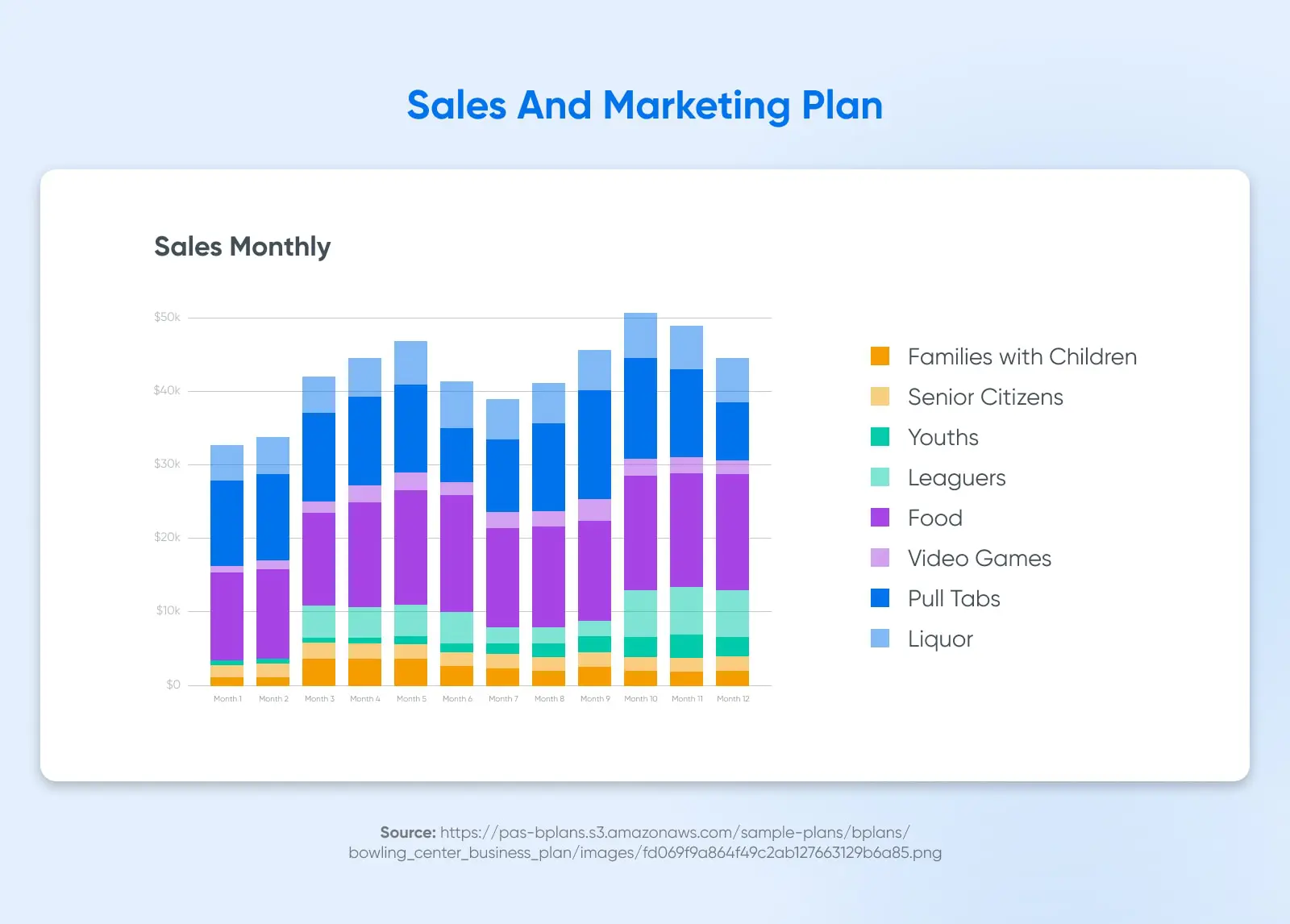
Step 7: Logistics and Operations
After detailing your sales and marketing strategy, the next step is to outline the logistics and operations aspects of your business. This section is where you demonstrate how your business will function on a day-to-day basis, including how it will deliver its products or services efficiently and effectively.
Purpose
The logistics and operations section serves to reassure investors and stakeholders of your business’s ability to operate smoothly. It shows that you have a clear plan for managing the resources and processes that are critical to your business’s success. This part of your business plan is about turning your ideas and strategies into concrete actions and measurable outcomes.
Components
- Logistics and supply chain management: Describe how your business will manage the procurement of raw materials, inventory, and supply chain operations. Detail any partnerships with suppliers or distributors.
- Production or service delivery: Explain the processes involved in building your product or delivering your service. Include information on manufacturing facilities, equipment needs, labor requirements, and quality control measures.
- Business locations and facilities: Describe the location of your business and the facilities required for operation. Explain why the chosen location is ideal for your business, considering factors like customer accessibility, cost, and infrastructure.
- Technology and equipment: Outline the technology and equipment your business will use. Describe how these tools will enhance your productivity, efficiency, and competitive advantage.
- Operations plan: Provide a day-to-day plan for your business operations, including roles and responsibilities of team members, workflow processes, and how you’ll handle order fulfillment and customer service.
Writing Tips For Your Logistics, Operations, And Finances Plan
- Be detailed and realistic: Give specific details to paint a clear picture of your business operations. Use realistic assumptions backed by your market analysis and sales strategies.
- Use visuals: Graphs, charts, and tables can make your business data easier to understand at a glance.
- Highlight risk management: Discuss any potential risks to your business operations and how you plan to mitigate them. This shows you’re prepared for challenges.
This section of your business plan is where you demonstrate your understanding of the operational details and complexities of running a business. It provides a clear roadmap for how you intend to transform your vision into a successful and sustainable business.
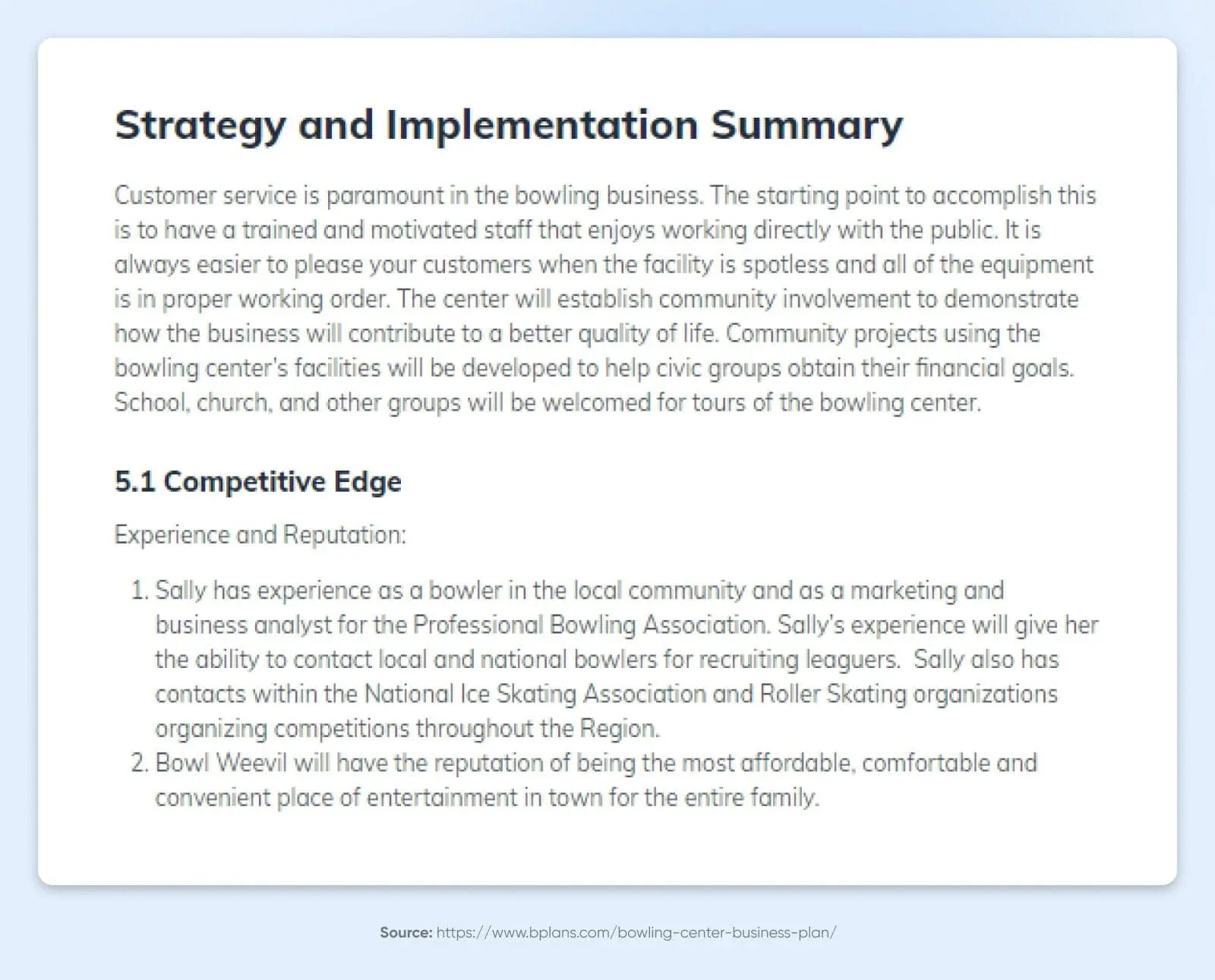
Step 8: Financial Projections
The financial projections section of your business plan is where you translate everything you’ve outlined into numbers. It provides a quantitative analysis of your business’s potential for profitability and growth.
In other words, this section clearly shows investors, lenders, and other stakeholders that your business is financially viable and can offer them a solid return on their investment. It’s where you make your case with numbers, showing the expected financial performance of your business over the next three to five years.
Purpose
Financial projections prove the economic sustainability of your business model. They offer a forecast of your business’s revenue, expenses, and profitability, and provide a clear picture of your financial health and growth potential. This section can help reassure investors and financial institutions that your business is a sound investment with a strong chance of success. It’s also a valuable internal tool for setting financial goals and measuring performance against those targets.
Components
- Sales forecast: Estimate the revenue your business will generate over a specific period, usually three to five years. Break down the forecast by product or service lines if applicable.
- Expense budget: Detail the costs associated with running your business, including both fixed and variable expenses. This should cover everything from rent and salaries to marketing and production costs.
- Cash flow statement: Provide a monthly or quarterly cash flow projection for the first year and annually thereafter. This will show how cash is expected to move in and out of your business, highlighting periods of cash surplus or shortfall.
- Income statements (profit and loss statements): Summarize your revenue, costs, and expenses to show your net profit or loss over time. This shows your business’s profitability and financial health.
- Balance sheet: A balance sheet offers a snapshot of your business’s financial position at a specific point in time, detailing assets, liabilities, and equity.
- Break-even analysis: Calculate the point at which your business will be able to cover its expenses and start generating a profit. This informs investors about the viability and risk level if they choose to back your business.
Writing Tips For Your Financial Projection
- Be conservative: We say it’s better to underpromise and overdeliver. Use conservative estimates that you can confidently achieve or exceed.
- Back up your projections: Base your financial projections on solid data and reasonable assumptions. Explain how you arrived at all of your numbers, referencing market research, historical data, or industry benchmarks.
- Highlight key metrics: Focus on key financial metrics that are most important for your business, such as gross margin, operating margin, and cash flow.
- Include scenarios: Consider presenting best-case, worst-case, and most-likely scenarios. This demonstrates thorough planning and shows that you’re prepared for different possible outcomes.
The financial projections section shows your understanding of your business’s financial dynamics and your ability to plan for its future. It’s not just about impressing investors — it’s also a must-have guide for your business’s financial strategy and management.
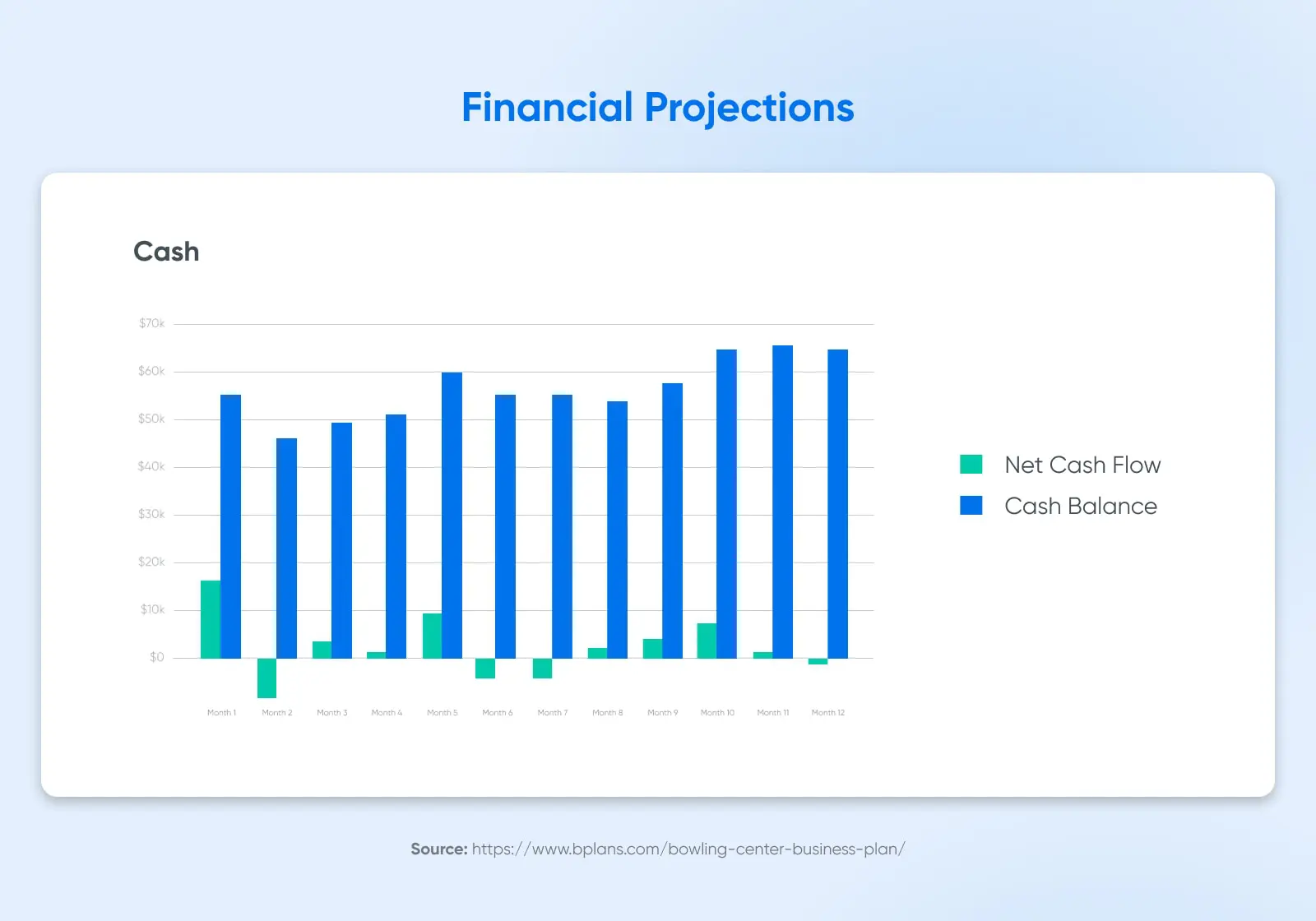
Step 9: Funding Request (Optional)
For many new businesses, securing external funding is an exciting step toward achieving their goals. This section of your business plan is where you detail your funding requirements.
Whether you’re seeking equity investment, a loan, or another form of financial support, the funding request section lays out exactly how much capital you need, how you plan to use it, and your preferred terms. This section is optional because not every business will seek external funding at the outset or as part of its growth strategy.
Purpose
The purpose of the funding request section is to provide potential investors or lenders with a clear and concise overview of your financial needs. It’s about articulating why you need the funds, how they will be used to grow your business, and how this investment or loan fits into your broader financial strategy. This section should align with your financial projections and operations plan, showing a direct link between the funding request and your business’s growth potential.
Components
- How much funding you need: Specify the total amount of funding you are requesting. Be precise, and make sure this number is supported by your financial projections and the way you plan to use the funds.
- Use of funds: Break down how the requested funds will be used. Categories might include product development, marketing, expanding operations, hiring key staff, or purchasing equipment. Be as detailed as possible to show investors how their money will be spent to drive growth.
- Type of funding: Specify the type of funding you’re seeking (e.g., equity investment, debt financing, grants). If you’re open to different types of funding, explain the conditions under which you would consider each.
- Terms: If you have specific terms in mind (for loans or equity investments), outline them here. For equity investments, specify the percentage of ownership you’re offering in exchange for the investment.
- Future funding: If you anticipate needing more funding in future rounds, mention this. Provide a brief overview of what those future needs might look like and how additional funds will help escalate your growth.
- Exit strategy: Especially for equity investors, outline your exit strategy. This could include acquisition, public offering, or buying out investors. It shows you’re thinking about the return on their investment.
Writing Tips For Your Funding Request
- Be direct: This is not the section for ambiguity. State your needs clearly and back them up with solid data from your financial projections.
- Align funding requests with your business plan: Your funding request should be consistent with your business plan’s other sections, especially your financial projections and use of funds.
- Focus on ROI: Investors and lenders are interested in the return on their investment. Highlight how funding your business will lead to a profitable outcome for them.
- Be flexible: While it’s important to specify your needs and preferences, also show that you’re open to discussions about the funding arrangement. Flexibility can be key to securing investment.
The funding request section is a direct appeal to potential investors and lenders to support your business’s growth. It should be persuasive, well-reasoned, and backed by the detailed planning you’ve put into the rest of your business plan. This section is your opportunity to make a compelling case for why investing in your business is a wise and profitable decision.
Downloadable Business Plan Template
By now, you should have a solid understanding of what goes into creating a comprehensive and effective business plan that can guide your business to success and attract the investment and support you need. Our downloadable business plan template makes this process even easier!
This template is designed to help you structure your business plan in a way that is clear, concise, and compelling. It includes all the sections we’ve discussed, from the executive summary to the funding request, with helpful prompts and tips to guide your writing. Whether you’re a first-time entrepreneur or a small business owner looking to expand, this template serves as a starting point to customize and develop your unique business plan.
How To Use This Template
- Customize it: While the template provides a general structure, it’s important to customize the content to reflect your specific business idea, market, and strategy. Make it your own by adding details relevant to your business and industry.
- Take your time: Writing a business plan isn’t a race. Use the template as a tool to organize your thoughts and research. It’s okay to take your time to ensure that each section is thoughtfully considered and articulated.
- Seek feedback: Before finalizing your business plan, seek feedback from mentors, peers, or professionals in your industry. Use their insights to refine and improve your plan.
- Update your business plan as needed: Your business plan should be a living document that evolves as your business grows and as market conditions change. Revisit and update your plan regularly to ensure it remains aligned with your business’s path.
And when your burgeoning business needs a reliable, professional website, consider professional WordPress hosting from DreamHost.
We offer plans to suit all budgets, whether you’re a small business just getting your start or an expanding enterprise. All plans include our WP Site Builder, which allows you to build a WordPress site in a simple drag-and-drop interface (or, if you already have a site, we’ll migrate it for you for free). They also come with lots of other goodies: a free domain, SSL certificate, professional email address, and privacy protection —- all the things your new business needs to thrive online!
Starting a business is no easy feat. But with a solid business plan and a great website, you’ll have a strong foundation to get you started.

Your Great Idea Starts with a Domain Name
Don’t let someone else register your URL. Search DreamHost’s 400+ TLDs to find the perfect fit for your website.
Master Your Domain
